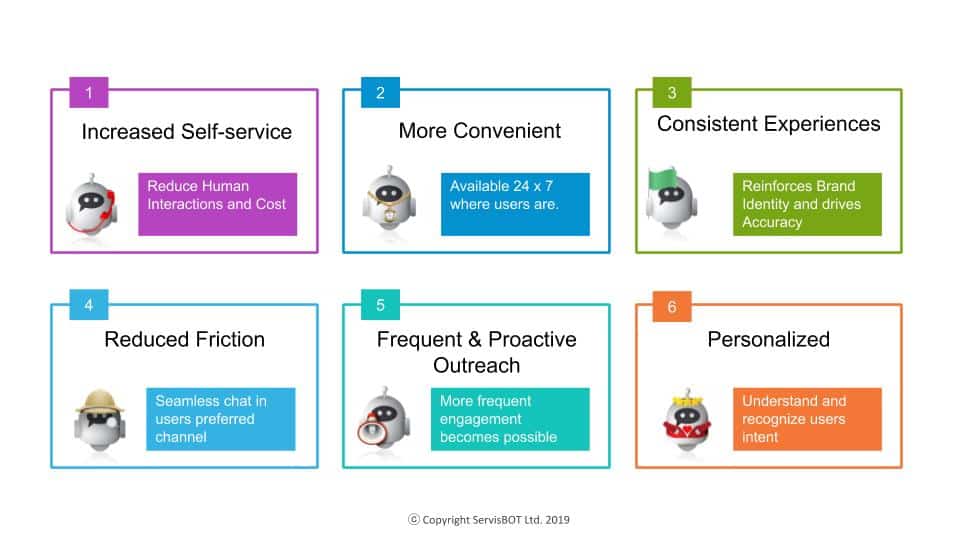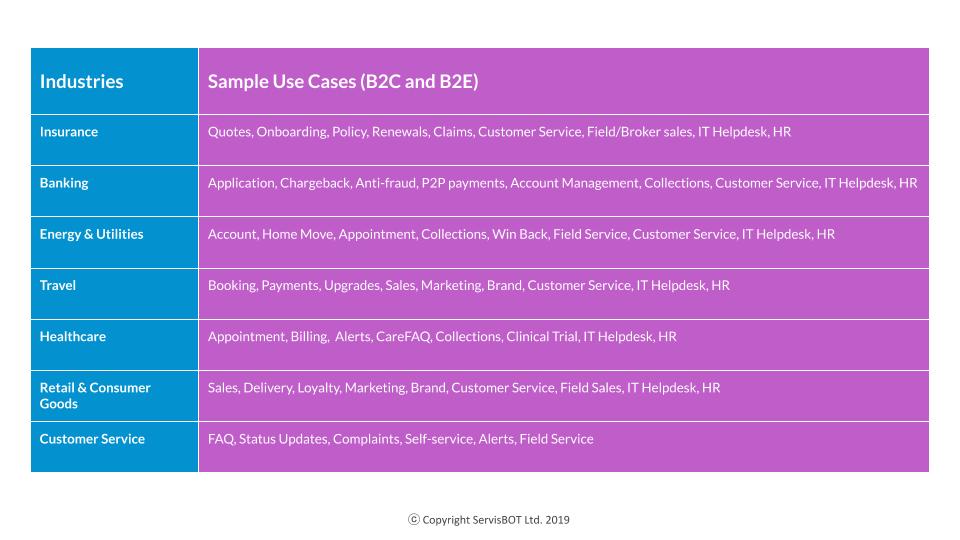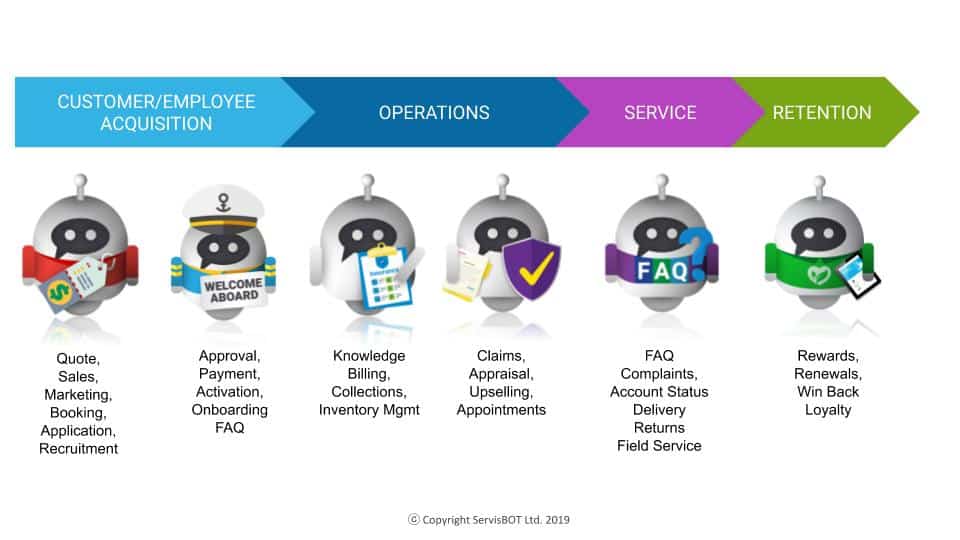Chatbots
What Chatbots are Right for your Business?
What chatbots could help your business engage better with customers or employees and generate better business results? This blog post explores some of the basics of chatbots, why they are so useful for business, and how businesses are using them. Let’s explore.
What is a chatbot?
Most of us know what chatbots are but we still come across people that aren’t quite sure what the difference is between a chatbot and live chat. So when you go to a website and a little avatar or window pops up asking you if you want to chat that is invariably powered by a human agent sitting in a contact center. It’s the modern-day equivalent of someone chatting to you by phone, except they are doing it via live texting in the pop-up window on their website or mobile apps.
But what if it’s not a human agent responding but rather a bot? Then this is a chatbot. In this scenario, it’s not always possible from the consumer’s perspective to differentiate whether they are “talking” (i.e. texting) with a human or with a piece of artificial intelligence software. And the better Conversational AI bots become the harder it is to make this distinction. One is human, the other is artificial, but they can be deceptively similar!
Simply put, a chatbot is artificial intelligence (AI) software that simulates a conversation with you using natural language. This can be using your voice or typing/texting. So whether you’re asking Alexa to reorder coffee from Amazon Prime or using text messaging in your banking mobile app to track your spending and complete transactions (e.g. Bank of America’s Erica) chatbots or virtual assistants are involved.
Why Businesses need Smart Chatbots?
Since we now have a whole new wave of conversational interfaces, from voice assistants like Alexa, Siri and Google Home to messaging and collaboration apps like Facebook Messenger, WhatsApp, Microsoft Teams, and Slack as well as the more traditional SMS and Email channels, businesses are eager to take advantage of these engagement channels.
However, the reality is that managing multiple channels and manually responding to a growing volume of customer and/or employee interactions across them is cost-prohibitive. But what if a bot can take on some of the more routine interactions and be available around the clock to answer customer queries or fulfill their needs?
- How can you enhance customer experience if your service teams are slammed handling requests and can’t manage incoming chats?
- How can you convert incoming leads into sales if prospects can’t access the right information to complete the sale?
- How can you drive greater employee productivity if knowledge is difficult to find and access?
These problems are not new for any business as they have grappled with multiple technologies and portals to help improve both the user experience and corresponding business results. However, to date, many engagements that customers or employees have with a business are fraught with friction and/or non-value-adding steps in unwieldy processes.
Graphical interfaces force users into structured and tedious workflows that don’t always make sense. Traditional out-dated processes in industries like insurance, banking, and healthcare often require multiple departments and manual document processing, adding delays, costs, and frustration to interactions. Enhancing the user experience remains elusive for many organizations, largely due to high degrees of friction, low levels of transparency, clunky and outdated processes, and lack of personalization in how they engage.
For companies that are willing to embrace change and really strive for a better experience, chatbot technology offers a great solution. However, some negative early press gave chatbots a bad rap, making some businesses apprehensive. This is understandable. Early implementations often failed because the chatbot was only trained to answer basic questions before quickly handing off to a human agent, so they were pretty useless.
Thankfully, advancements in natural language understanding (NLU), the emergence of enterprise ai bot platforms, and maturing approaches to chatbot implementations have led to a better understanding of the true value that chatbots can bring across complete user lifecycles and a more sophisticated approach to their implementation. Any business that relies intensively on interactions, whether with customers and/or employees, can now enjoy the age of smart chatbots.
Six Ways that Business Chatbots are Useful?
Here are six core characteristics that make chatbots so powerful.

Increase Self-service. A chatbot has the capability to replace human interactions on routine tasks, automate workflows, and fulfill the user’s need to the best of their ability. This helps drive up self-service levels for a business that not only is attractive for users but also offers more cost-effective employee and customer support across different interaction points. Needless to say, this doesn’t mean that human intervention is eliminated and that support staff becomes redundant. The chatbot just takes on the tasks that they can execute but hands over to a human if it becomes more complex or if a user requests to speak with an agent. Self-service is a great way to reduce the heavy load on a help desk or customer service center and ensure that users aren’t left hanging or are dropped. It also allows human staff to become more productive as they handle more complicated engagements or resolve more complex problems, rather than waste time on basic requests such as a password reset, card activation, or FAQs.
More Convenience. Chatbots don’t need to eat, sleep or take a vacation. They can work 24×7 without violating employment laws. This means they are available as much as the business wants and needs them to respond to out-of-hours requests. Since we can’t determine when an accident will happen and we need to file a claim or we are busy at work during office hours and can’t get around to applying for a car loan, being able to engage with a business after hours provides a level of convenience that is expected by today’s consumer. But this also benefits a company. For example, by providing a chatbot to handle insurance quotations one of our insurance customers noticed that the sales conversion rate went up partly due to the chatbot being able to respond to queries when the contact center was closed. (See the Insurance bot case study) Sales opportunities are not lost but even better, there is no additional cost to having a chatbot work all day and night.
Consistent Experiences. Artificial intelligence offers the capability for a virtual assistant to respond more consistently and accurately to customers but without bringing them through an unnecessarily rigid workflow. Conversations can be designed using the brand’s tone so they can deliver a more consistent brand identity that is harder to achieve with human staff. A chatbot can also automate workflows that are manual and error-prone, increasing accuracy levels. Also, as multiple chatbots are built for different interaction points and use cases it’s possible to centralize core components such as language, business logic, and small talk and make them available to all the bots.
As AI continues to evolve, it’s becoming increasingly clear that generative AI impacts brand identity in significant ways. By enabling the creation of highly personalized and engaging content, generative AI helps companies to establish a stronger, more consistent brand presence across all customer touchpoints.”
Reduced Friction. Conversational interfaces and chatbots remove a lot of friction in how we can interact with a business. Rather than going through clunky web forms or scanning and emailing document attachments, it’s possible for a chatbot to request an image upload from a user and extract and validate the required information, all within a single conversation. So take an example of onboarding a new insurance customer where proof documents can be uploaded by the customer and verified by backend systems and where customers can ask policy questions and get immediate responses from the bot. It’s mind-boggling to think that some of these journeys that we associate with so much friction and time-consuming tasks can be simplified with the combination of conversational interfaces and artificial intelligence.
Frequent and Proactive Outreach. Chatbots aren’t just for answering inbound requests. They can be proactive too. And since it doesn’t cost to have chatbots reach out to users they offer another layer of possibility to an engagement model. Chatbots can play an important part in customer retention, renewal, collections, loyalty, performance, or programs that would benefit from more frequent interactions throughout a particular lifecycle or process.
Personalization. Artificial intelligence and machine learning enable greater personalization of user experiences, which is an increasingly key expectation and differentiator. Chatbot solutions that can draw on business and third party data and that get smarter over time through the application of AI technology can deliver personalized experiences at scale.
A Plethora of Chatbots for Business
Many different industries are turning to chatbots in an effort to achieve business improvements and transform how they interact with their users. Companies from industries that are interaction-intensive have a lot to gain by putting chatbots to work. Examples of these vertical industries are Insurance, Banking, Retail, Travel, Entertainment, Energy, Utilities, and Consumer Goods. There are also the classic Contact Center and Business Process Outsourcing companies that handle customer interactions at massive volumes.
But what kind of chatbots are being implemented by these businesses? It varies by industry but also by the company. This is natural since business objectives and requirements differ from one company to the next and chatbot use cases are closely aligned with these business goals. Some organizations start with internal employee bots, some with customer-facing ones.
Some chatbot use cases by industry

Thinking of chatbots in terms of the user lifecycle sheds light on some interaction points that may not be as obvious as typical service or support interactions. This means looking at the very first interaction that someone may have with a company, converting them to a sale or a new hire, managing them through different operational points and giving them access to information, providing service and support, and in some cases handling their renewal or their exit. Different chatbots can be created and deployed to interact with the user from the acquisition stage to the end of the lifecycle and every point in between.
A Lifecycle Approach to Chatbots

What is the best way to get started with chatbots?
From our experience at ServisBOT each client has different business reasons for their initial chatbots. Some start with a simple internal FAQ bot while some of the more adventurous ones begin their journey with a sales chatbot or a chatbot for banking that may be focused on converting incoming leads by guiding someone through a quotation or application workflow through their web or mobile apps. Others have honed in on the onboarding process as a means to get users up and running as quickly as possible and thereby generating revenue or productivity as quickly as possible. The use cases for chatbots are plentiful and once a company sees the results from their first rollout they quickly realize that there are plenty of other attractive business opportunities for further chatbots.
If you are thinking about building chatbots for your business we have a number of resources that are helpful to get you started. Our chatbot template has over 100 Questions that you can think about if you are crafting an RFP template.
